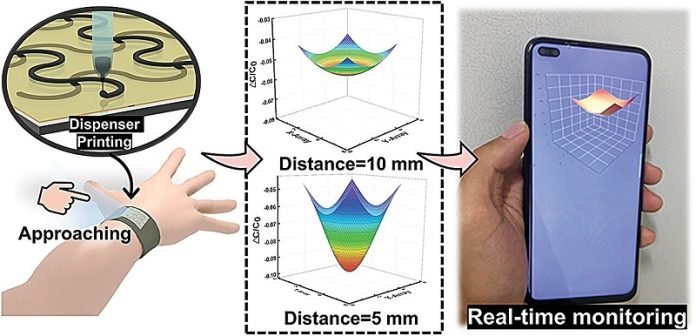
Scientists from Qingdao University in China, along with their colleagues from China and South Korea, have made a groundbreaking discovery in the field of robotics and wearable technology.
They’ve developed a new type of sensor that is so advanced, it can detect objects without even touching them.
This new sensor can sense objects from up to 100 millimeters (about 4 inches) away, simply by detecting changes in the electric field around the object.
This exciting development was shared in the Science and Technology of Advanced Materials journal.
Traditionally, robots and bionic devices rely on touch-sensitive technology. These systems need to physically touch something to sense it, whether it’s to understand its shape or to grasp and move it.
However, the new touch-free sensor changes the game by detecting objects in its vicinity without any direct contact.
The secret behind this sensor’s sensitivity lies in its unique composition. The researchers created a special blend of materials that, against all odds, has a lower ability to respond to electric fields than either material alone.
This blend combines small amounts of graphitic carbon nitride with a polymer called polydimethylsiloxane.
Together, they create a composite that’s perfectly tuned for detecting electric fields, more so than anyone expected.
This innovative composite can be shaped and structured precisely using a 3D printing technique known as dispensing printing. This method allows for the creation of intricate patterns and structures with the composite material, essential for the sensor’s function. The researchers crafted a grid-like sensor capable of sensing objects from a distance, without needing to touch them.
The team tested this sensor by moving their fingers close to, but not touching, the sensor’s surface. The results were remarkable. The sensor could detect the fingers’ presence quickly and accurately, demonstrating its potential for a wide range of applications, from advanced robotics to wearable health monitors.
This technology isn’t just for robots. It’s also perfect for creating flexible sensors that can be worn on the body. These could be used for health monitoring or integrating into the rapidly expanding Internet of Things (IoT). In the IoT, devices communicate and interact with each other over the internet, and touch-free sensors could allow for new ways to control and interact with these devices.
Moreover, the researchers have integrated this sensing technology into printed circuit boards. This integration enables the sensor to transmit data over 4G networks, which are commonly used by smartphones. This means the sensors could send information directly to your phone or other devices, making them even more versatile.
Looking ahead, the team at Qingdao University plans to refine their sensor for mass production. They’re also exploring other potential uses, such as gesture recognition for human-computer interaction and motion detection for obstacle avoidance and medical monitoring.
This breakthrough in touch-free sensor technology opens up a world of possibilities for robotics, wearable devices, and beyond. With its ability to detect objects without physical contact, it could revolutionize how machines interact with the world around them and how we interact with our devices.
Source: KSR.



